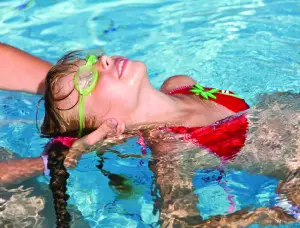 An estimated five to 10 million infants and preschoolers participate in formal aquatic instruction programs throughout the United States. Programs for the littlest water bugs focus on getting them comfortable in the water as well as helping parents become aware of basic safety measures (for instance, whenever infants or toddlers are in or around water, an adult should be within arm’s reach, providing “touch supervision”). But when your child hits the age of four, he is developmentally ready to undergo formal swimming lessons. And every child should learn how to swim to reduce the risk of drowning.
An estimated five to 10 million infants and preschoolers participate in formal aquatic instruction programs throughout the United States. Programs for the littlest water bugs focus on getting them comfortable in the water as well as helping parents become aware of basic safety measures (for instance, whenever infants or toddlers are in or around water, an adult should be within arm’s reach, providing “touch supervision”). But when your child hits the age of four, he is developmentally ready to undergo formal swimming lessons. And every child should learn how to swim to reduce the risk of drowning.
“The best approach is to make everything about water fun and positive,” says Caroline Kaczor, aquatics and health director at Sportime NY. “Take baby steps,” she suggests. “At bath time, start small by getting your child to pour cups of water on his or her head. Let your child lead the operation depending on her comfort level.”
But what if your son or daughter isn’t so eager to get wet? Whether due to fear of the water or a simple aversion to feeling cold, some youngsters just don’t want to get in the pool to learn. Remember that, as Kaczor reiterates, “It’s best not to force anything if the child is fearful.” But there are always measures parents can take to ease their child’s transition from non-swimmer to willing participant. To help you, we asked local experts in Queens – including aquatics instructors and summer camp directors – for their advice.
Ask the Experts:
How can I encourage my child to learn how to swim if she is completely uninterested or afraid?
“Just like you have to make sure that your children eat a well-balanced diet instead of junk food, you also have to make sure that they learn to swim, even if they don’t want to. The fear of swimming may never go away. Therefore, waiting will not help. You must always be sensitive to children’s fear and discomfort in the water, but must proceed with lessons for their own safety.
In a formal lessons setting, try telling your child that the instructor will take her in. The instructor, who must be smiling and playful, must then immediately take the child into the water. The hope is that your child will realize that it is fun and safe to swim with the instructor and will want to continue with the lesson. You might also want to make an effort/reward deal with your child. Promise her a present every time she goes to a lesson and makes the effort to learn.
It is very important that you never lie to your child so you can keep the trust there. Sometimes it is better to take baby steps. Have your child watch a lesson from the side of the pool with just her feet in the water, and then go in quickly at the end of the lesson. Try to improve on that every lesson thereafter. A little progress is still progress!”
-Lior Harpaz, director of aquatics, Central Queens Y, Forest Hills
“Not building a fear of the water is important. Always start off slow, putting the child on the deck of the pool with his or her feet in the water. Be patient, as it can take a few weeks to ease them into the water. Once they become comfortable with their surroundings, then children’s fear of the water tends to go away. Never push or force a child into the water; that will just create a bad experience that will be remembered forever.”
-Howard Seidman, camp director (and former aquatics instructor), Hillcrest Jewish Center Day Camp, Fresh Meadows
“The most important thing to teach a child who is afraid of the water is a proper air exchange. That is when a child can inhale above water and exhale under water in a slow and rhythmic pattern. However, teaching a proper air exchange on a child who doesn’t want to leave the arms of his parent can be a lot easier said than done! Here are a few tips to help.
First, on land, have your child practice holding his breath. Then specifically hold the breath for a count of three seconds, then exhale. The next step is to get him used to the water. Remember to start ‘water to face’ by having the child splash water on himself. Then go ‘face to water’ by having the child dip his face into the water. You can then help him progress to holding breath under the water, then blowing bubbles under water so the exhale is happening while submerged. Eventually, your child should be able to come up for air while holding onto an adult, inhale out of the water, and put his face back under.
If a child can learn this important life-saving skill, this will help him to get over the fear of water. Remember: Always try to create an environment that is engaging, fun, and informative. A good swim instructor will always remember to demonstrate, explain, and then practice.”
-Lauren Lent, vice president of the Board of Governors, Bay Terrace Country Club, Bay Terrace
“Establish pool safety rules such as: only enter the pool if an adult is watching; and, no running around the pool area. Don’t focus on what can happen if the rules are broken, but be clear that the rules must be followed.
Trust is extremely important. If you say that you’ll be there to catch your child, show him continually that you will catch him when he says he needs you. Show your child how much fun you have while swimming in the pool as he watches from the side. This may make him want to join you.
Most of the children I’ve worked with who were fearful or uncomfortable about swimming began to enjoy the pool experience while sitting on the first couple of steps. Let children play with underwater dive toys in the shallow water from the safety of the steps, where they feel comfortable and in control of the situation. When you’re little, that pool can look extremely daunting! Practice kicking, putting her face in the water (even if it’s just a little bit at a time) and reaching underwater for toys. The more at ease the child is near the water, the more likely she will have the desire to learn how to swim.”
-Caroline Kaczor, aquatics and health director, Sportime NY, with locations on Randall’s Island, in Westchester, and throughout Long Island
Also see more advice from experts in your area.





















